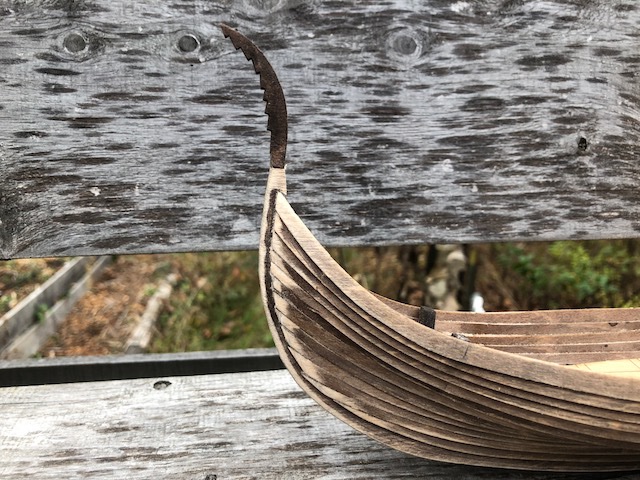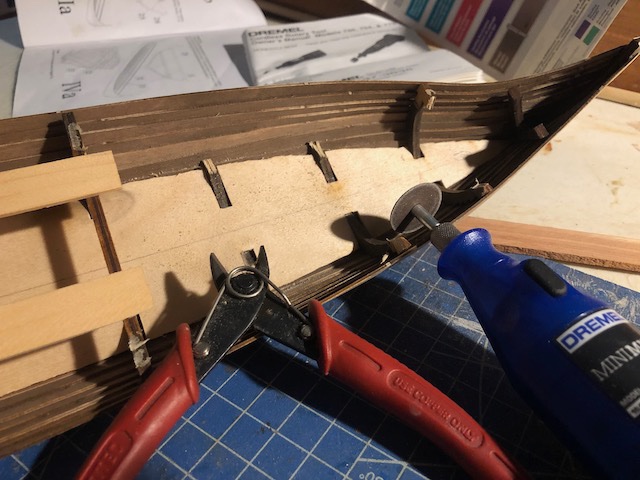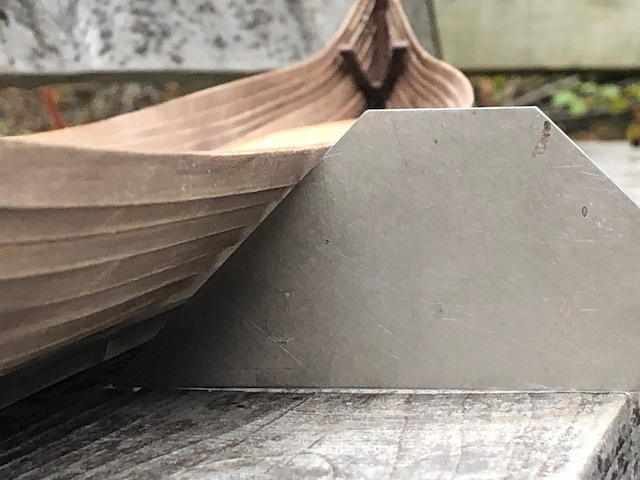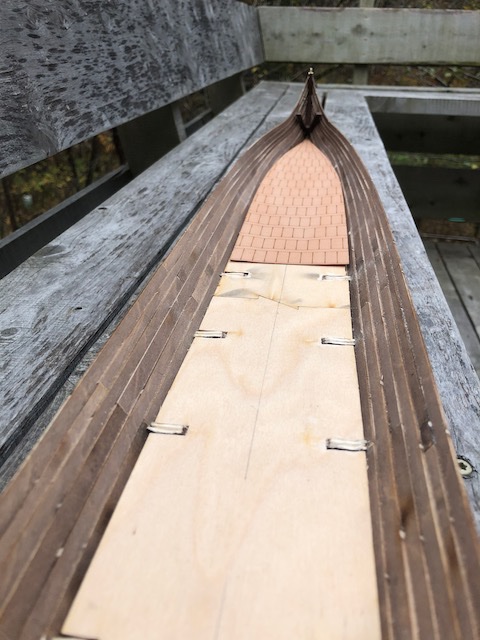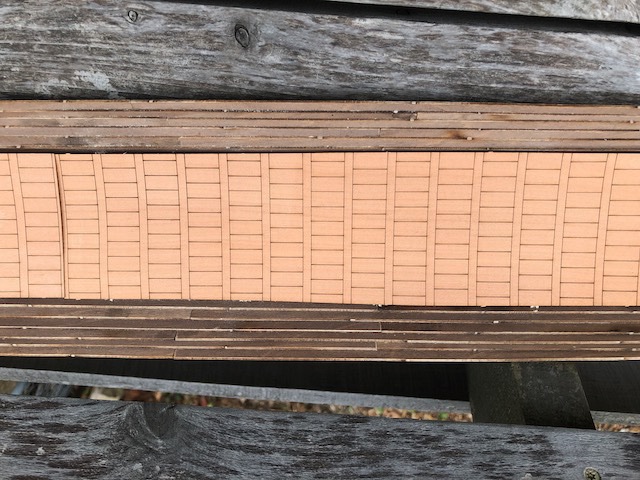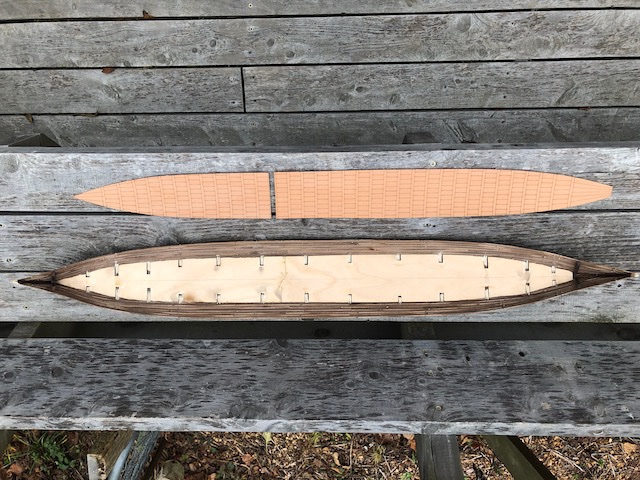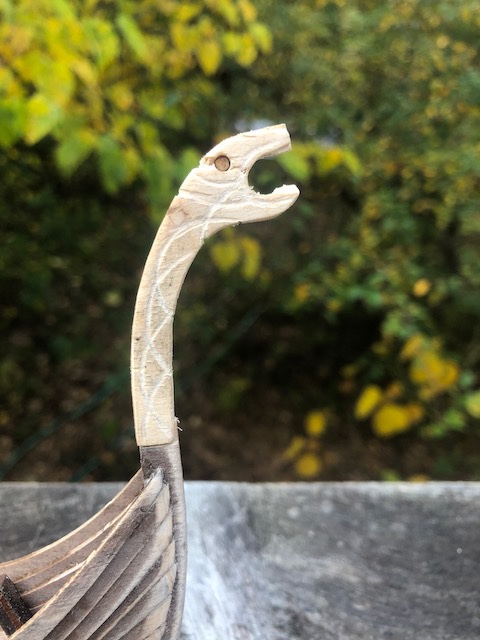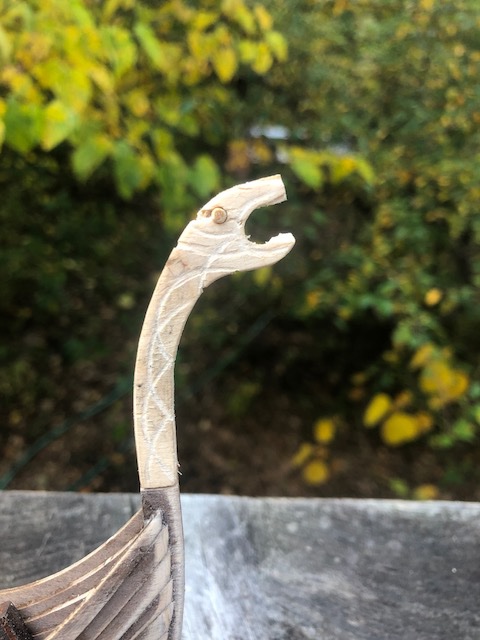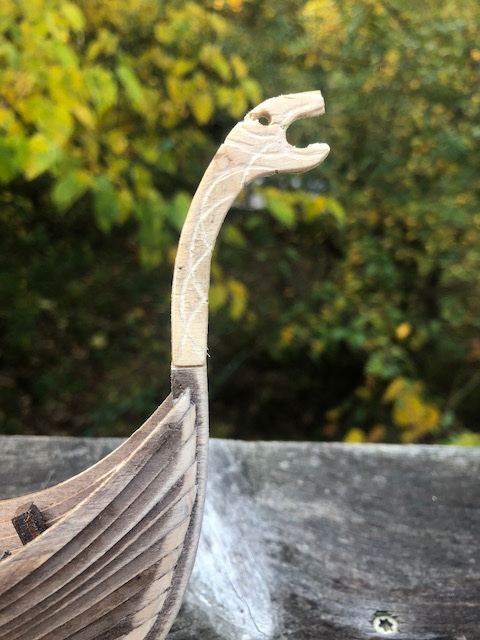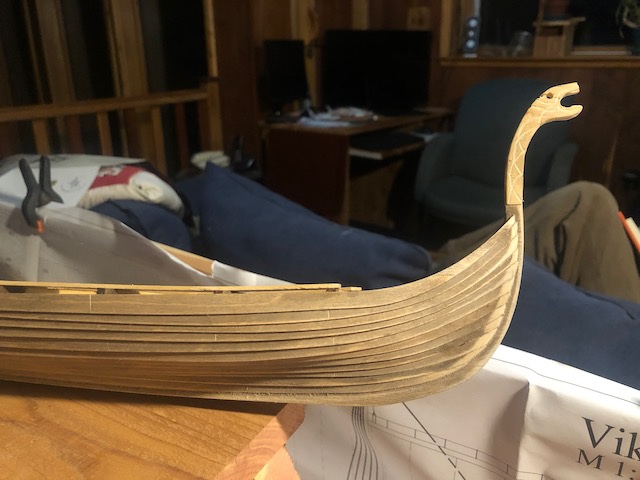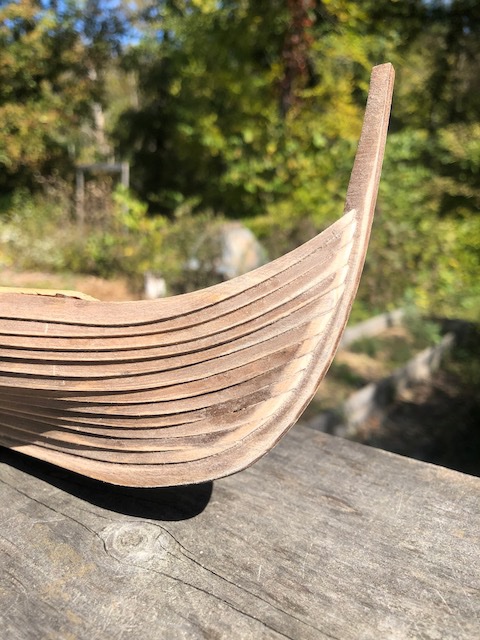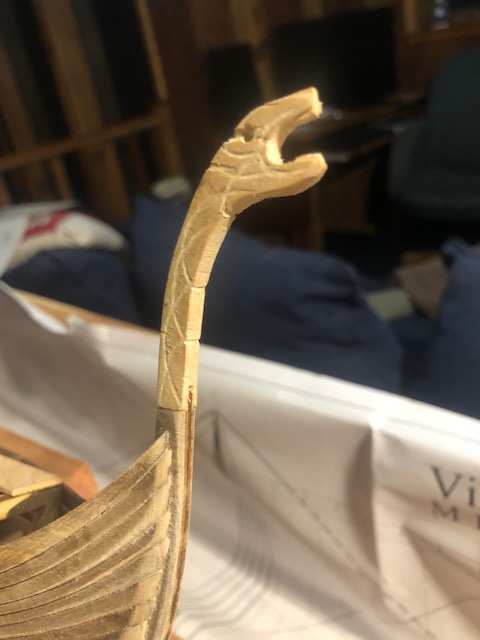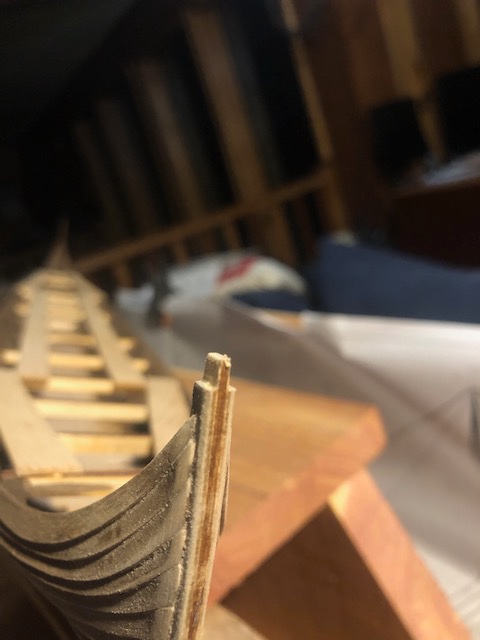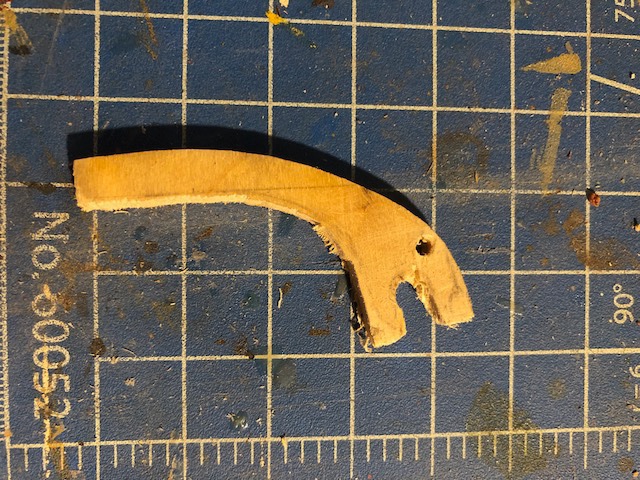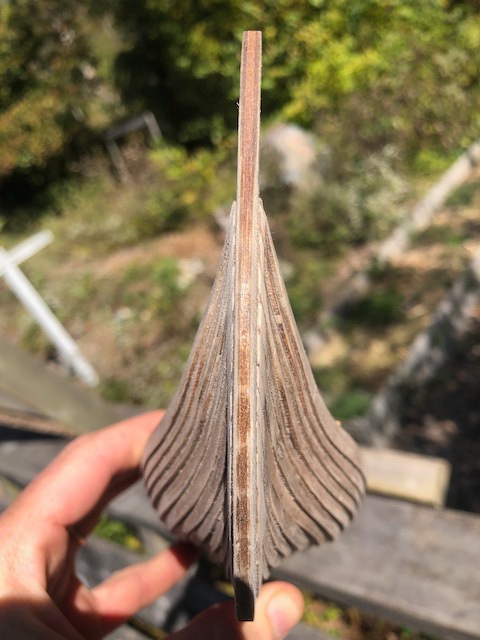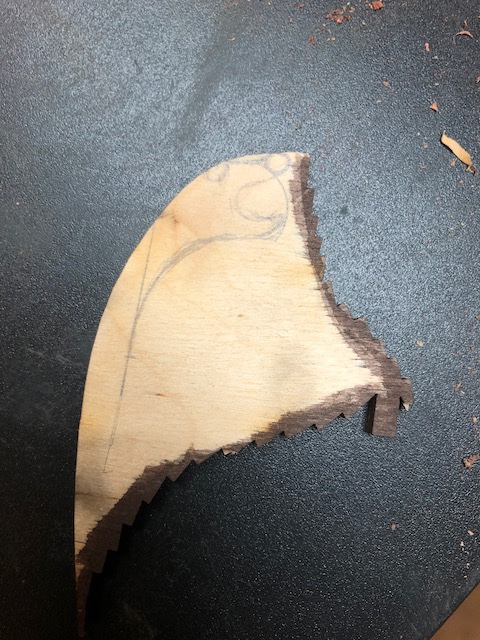-
Posts
3,535 -
Joined
-
Last visited
Content Type
Profiles
Forums
Gallery
Events
Everything posted by Cathead
-
Would an option be to have the templates printed on single larger sheets of paper through an office store? I believe you can submit files online and pick up the printed product. That would mean the whole thing would be at one scale. Whether it would be precisely accurate to what you intended, I don't know.
-
A bit more progress. First, I played around with various ways to make a tail at the stern. Lots of sources have coiled tails, but I was unable to replicate this with my tools and skill set. So after much frustration, I decided to come up with my own tail. I wanted it to be visually distinct, at least somewhat representative if not necessarily accurate, and able to be made from the same plywood as the keel so I could slot it in easily like the dragon's head. I finally hit on using the notched edge that mirrored one of the clinkered frames; I think it came out looking reasonably nice. Evocative, if not accurate. I then moved on to the major step of removing the frames. As you may or may not recall, these need to be removed above deck level as the real vessel had no equivalent structures. I did not glue the planks to the frames above that level in order to ease this process. It was still rather hairy, as there was no good access for any kind of saw or tool. I tried a small Dremel motor tool with a cutoff blade, but was terrified of slicing the planking. I tried a small razor saw and a knife, but the plywood is hard and they really didn't have a good angle either and doing it that way kept putting stress on the hull (I've had enough problems already with planks separating from one another). Finally I tried a pair of shears, which came closest to a flush cut and didn't risk damaging the planking. Here's what the first rough cuts looked like in progress (rejected Dremel also shown): For anyone making this in future, note that I cut away the top of the frames first, then the "ribs", as the top parts got in the way. Once all the frames were cut away, I used a sanding drum on the Dremel to finish lowering them to at or below deck level. This worked very nicely and was easier to control in terms of not damaging the planking. Here's what the cut-off and sanded frames look like: The kit provides a thin pre-scribed false deck, shown in part above. I think it's ugly and it doesn't quite fit my hull anyway. Here are a few more shots of it: From the beginning, my plan has been to discard this and install individual deck planking, as I think this will look a lot nicer. So that's the next major step to undertake. Finally, I want to return to my intense frustration with the shape of the hull. As noted before, this was supposed to finish at a near vertical angle, but instead the planking bowed outward and finishes at a roughly 45 degree angle that is well below its intended head amidships, as shown below. Also, if you look in the background of the photo below, you can see that the kit's final frame (which is supposed to remain in place) doesn't come close to matching the natural curve of the planking. I finally stopped trying to force the last few planks to meet this frame, which made the final planking go easier but results in a rather awful looking gap between frame and planks. In theory I could have avoided this by gluing the planking onto all the frames, but I didn't want to do that as it would have meant very delicate removal of the frames later on, including glue stains that would have been very difficult to get rid of. I thought that soaking and clamping the planks to the frame during gluing would have been enough, but clearly this hull has a mind of its own. If I did this again I might try it to see what happened, but the instructions were so poor that I had to make a judgement call on what to do and am now living with that choice. I really don't know what to do about this. I could try to add one or more new strakes, but (a) I don't have any good material for that and (b) they would have to go through a rather abrupt change in angle from the previous plank to get even close to vertical. I could leave it as-is, but it'll look ridiculous with oar ports drilled in facing the sea at a 45 degree angle and the really low freeboard will be awkward as well (the rowing benches will be near the top of the planking amidships). I've been thinking about installing oarlocks atop the final plank (rather than oar ports drilled in it) to at least raise the height of the oars, like those seen here and here. This is also because I don't like the idea of drilling 60 holes in this delicate model and having no way to fix something that goes wrong. My current plan is to work on the deck and let the hull decisions fester for a while. I often come up with new ideas or solutions over time, and the deck work is independent of the rest. Updates will continue to be intermittent. Real life is pretty hard right now, our time is being swamped by a complex and ever-worsening situation with my in-laws that I'm not going to get into online, but which is overwhelming our mental, emotional, and physical capacity to deal with other issues. Although hobbies can be healthy distractions, this project is anything but relaxing and I'm not finding a lot of time or motivation to work on it lately. Thanks for understanding.
-
I've got a Viking ship you're welcome to finish. I'll happily pay to ship it to Australia. Otherwise it may end up at the bottom of my pond.
-
I think you mean "hoops", the metal rings that hold the barrel staves together. "Coops" contained chickens. The barrels look nice, as does the rest of the model so far.
-
Oooh, my turn to show off pedantic knowledge! Geologically speaking, porphyry is an igneous rock (formed from cooling lava), whereas marble is metamorphic (physically and chemically transformed from limestone). However, in the building trade, "marble" is routinely used to refer to any crystalline rock that can be cut and polished regardless of origin. "Granite" is the same way in kitchens and baths; most "granite countertops" cause a geologist to bristle. Anyway, aside from the rare pleasure of applying my geologic background to model building, this has been such a wonderful journey through a period and ship-building style I knew nothing of. Thanks for sharing so much detail and context with us along the way. I am much the better for it. Also, what happened to the horns on the guards' helmets? (ducks)
-
Art is so subjective. To my modern eye, influenced by Chinese concepts of dragons, most Viking dragon heads look more like cheetahs.
-
Looking very nice. Love the distinct style of this vessel.
- 28 replies
-
- Amati
- chinese junk
-
(and 1 more)
Tagged with:
-
One of the most basic questions to answer is your skill level at assembling models and what materials you want to work with. Your phrasing "put together" implies a pretty basic model, based on assembling pre-made parts with glue, which suggests a simple plastic model. For example, a couple Revell sailing ships (Bounty and Charles Morgan whaling ship) were my first entry into ship kits and look reasonably cool without needing more skills than basic gluing and painting. In contrast, most wood-based kits are not going to be "put together" because almost all require more work shaping the parts first and this can quickly get challenging if you aren't aware of what you're getting into. BlueJacket makes a whole series of intro-level wood kits that look nice and are meant for beginners. I strongly recommend reading the link Meddo gave above. But it would help to know some basic ground rules for type. Tugboat? Canoe? Sailing vessel? Battleship?
-
Thanks, Louie! Good to hear that I'm on the right track. As you suggested, not going for anything fancier, I don't have the skill and the plywood is hard enough to carve at this level given its coarse, strong grain. Here are three options for the dragon's eye. Empty: Protruding: Recessed: My current plan is to have the figurehead itself the same dark color as the hull, but the carved designs, teeth, and eye highlighted in colors like red and/or yellow to match certain strakes on the hull.
-
I started sanding the hull, smoothing off each strake and getting rid of any glue, while blending in the bow and stern planks. Here's an example so far: The difference in color from the stain wearing off doesn't matter as I'm going to paint all these darker. Probably didn't need to stain at all but I wasn't sure of that when I started. Here's an end view: I think it's starting to look nicer already. Having a lot of issues with planks popping loose, I've had to reglue three different stretches where the seam came undone. Not at all pleased with how fragile this is even with my extra gluing surface. I also finally started working on something more fun: a proper figurehead. There's a lot of disagreement out there about these, with different original sources and academics contradicting one another. This is especially true for the idea that figureheads may have been removable, the idea being that you would remove them when approaching friendly shores to avoid frightening land spirits but would keep them in place for more aggressive landfalls. This is mentioned in some Icelandic sagas, but to my understanding no archeological evidence for this has been found. I decided to add a removable figurehead to my vessel as (a) I love the concept and (b) there is at least cultural support for it. I'm not trying to recreate the original vessel here, just my version of a wealthy jarl's warship. I based my design from several actual carved dragon heads found in various archeological contexts. I used a piece of the same plywood sheet from which the keels were cut. This ensure that the wood was the same thickness. I used a piece with a curved edge on the outside (this came from the inside of the stem) and traced a rough concept onto it: I then roughly cut this out and did a lot of filing and sanding to get closer to the right shape: To mount this on the bow, I made use of the three-layer plywood, which likes to separate along the surface between each sheet. So I cut down the stem and cut away the outer two sheets to leave just the middle one in place: I then carefully cut away the inner piece on the end of the figurehead to make a matching slot: You'll also notice that I carved some patterns on the figurehead, again loosely following various real items. I again took advantage of the three-layer plywood to develop some details in the teeth and nose, though it seems this photo doesn't do it justice. Will try to take a better one in daylight. So here's what the semi-final product looks like: Needs some touchup work but you get the idea. I have two thoughts on the eye: either leave it empty like that or run a rod through it so the eyes stick out from the side of the head. Leaning toward the latter (will try to take better photos in daylight). I'm also going to drill a hole through the mount to simulate a large peg that might have been used to fix this in place (and remove it). I'm going to highlight the carved patterns in different colors. None of this is permanent, but it was fun to develop and starts to give the vessel a unique feel. Thoughts?
-
That's what I would have tried first. Another, possibly crazy idea, might be to make a pattern of the curve you want (like by bending a piece of wire in-place on the model) and then using that as a guide to shape a glue-soaked line that dries off the model and then is installed when stiff?
-

Chaperon by joep4567 - 1:48 - Sternwheeler
Cathead replied to joep4567's topic in - Build logs for subjects built 1801 - 1850
They fit in nicely and help make the build even more your own. -
I often use pastels to dull model surfaces by dry-rubbing them in with either a fingertip or brush. They can add a nice complex texture to a surface. A cheap box of pastels can last a lifetime of light weathering and could help dull the rope coils. Not sure how it would work in your specific situation but you could test it on an off-model coil to find out. Just a thought.
- 950 replies
-
- syren
- model shipways
-
(and 1 more)
Tagged with:
-
Nice job on the coils. I've done that by coiling the line onto a piece of double-sided tape but your methods looks faster and the results are nice.
- 950 replies
-
- syren
- model shipways
-
(and 1 more)
Tagged with:
-
It won't feel real until I see her on the nose of a B-17.
- 599 replies
-
- sidewheeler
- arabia
-
(and 4 more)
Tagged with:
About us
Modelshipworld - Advancing Ship Modeling through Research
SSL Secured
Your security is important for us so this Website is SSL-Secured
NRG Mailing Address
Nautical Research Guild
237 South Lincoln Street
Westmont IL, 60559-1917
Model Ship World ® and the MSW logo are Registered Trademarks, and belong to the Nautical Research Guild (United States Patent and Trademark Office: No. 6,929,264 & No. 6,929,274, registered Dec. 20, 2022)
Helpful Links
About the NRG
If you enjoy building ship models that are historically accurate as well as beautiful, then The Nautical Research Guild (NRG) is just right for you.
The Guild is a non-profit educational organization whose mission is to “Advance Ship Modeling Through Research”. We provide support to our members in their efforts to raise the quality of their model ships.
The Nautical Research Guild has published our world-renowned quarterly magazine, The Nautical Research Journal, since 1955. The pages of the Journal are full of articles by accomplished ship modelers who show you how they create those exquisite details on their models, and by maritime historians who show you the correct details to build. The Journal is available in both print and digital editions. Go to the NRG web site (www.thenrg.org) to download a complimentary digital copy of the Journal. The NRG also publishes plan sets, books and compilations of back issues of the Journal and the former Ships in Scale and Model Ship Builder magazines.



